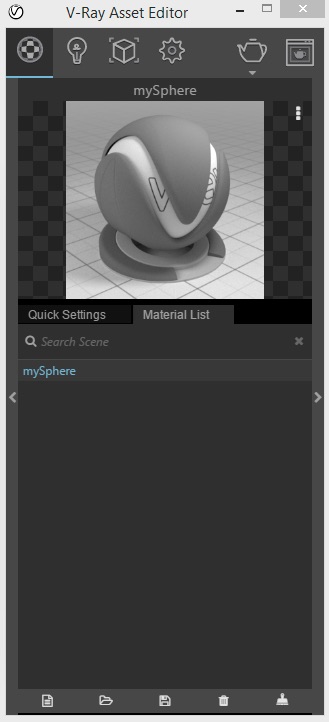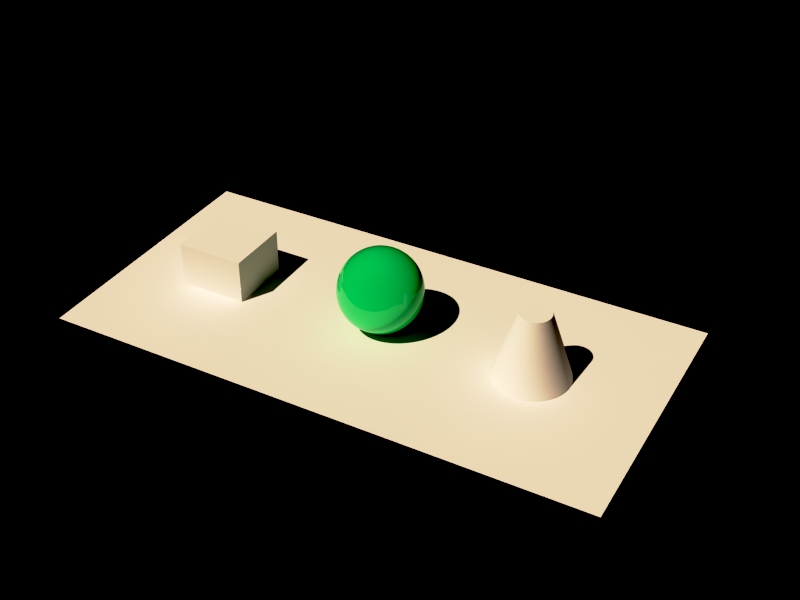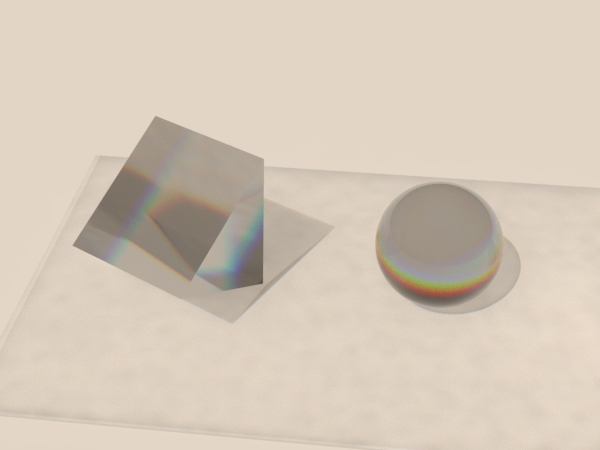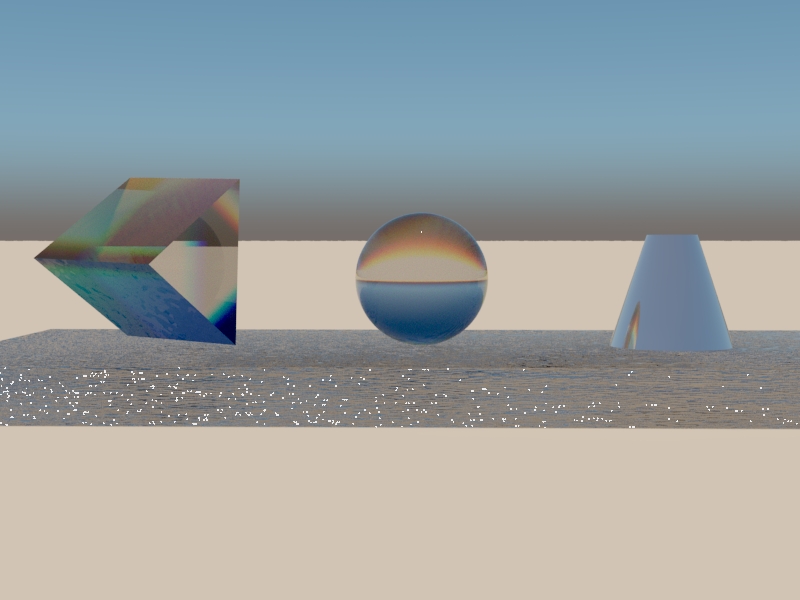How To Create Gold Material In Vray
COMPUTER AIDED ARCHITECTURAL DESIGN
Workshop 7 Notes, Week of October 16, 2018
BRDF MATERIALS
Bidirectional Reflective Distribution Function (BRDF) defined material is a physically based description that examines how incident light on a a surface is can be either reflected, absorbed or transmitted. BRDF describes how much light is transmitted when it makes contact with specific materials (for a more complete description see An Introduction by Chris Wynn at NVIDIA). For more general on-line tutorials and reference materials on V-Ray see https://docs.chaosgroup.com/display/VRAYRHINO
This tutorial is developed after the treatment http://viscorbel.com/vray-materials-theory/ posted on viscorbal.com.
1. Create a Rhino File with a ground surface, box, sphere, truncated cone and V-Ray sun light, and create the setup below using methods covered in earlier tutorials. Create separate levels for a) the ground surface, b) the box, sphere and truncated cone, and c) V-Ray sunlight.

2. Within Rhino, go to the menu item "Render>Current Renderer>V-Ray for Rhino" to ensure that V-Ray is active.
3. To activate the V-Ray material editor within Rhino, go the the "Vray Asset Editor", and in the dialog box that follows, go to the tab "Material List" and create a new so-called "Generic Material" and rename it "mySphere" similar to workshop notes 6.
4. Select the "Quick Settings" tab and expand it by clicking on the arror at the middle of the right-hand side. Note that we will focus on "Quick Settings" on the lef-hand side, and "BRDF" on the right -hand side of the dialog box. 
5. Within "Quick Settings", the Diffuse Color establishes the base color of the material from the color selector and can also be specified in terms of RGB and HSL format. The number associated with "Rougness" on the right-hand side controls the flatness of the material on a scale of 0 to 1. For example, make the color a light green by selecting the "Diffuse" color. Revised "Diffuse" setting:
Adjust the "Roughess" to 0.5 and preview it again. Note that adjusting the "Roughness" may appears to soften and diffuse the highlight on the sphere making it look flatter. 6. For the same material, adjust the "reflect" color on the right-hand side towards neutral gray and preview the result. The sphere begins to show a spectral highlight.
Apply the material to the sphere within the Rhino model. Complete the rendering and note the lack of a highlight on the sphere at this setting for "reflection".
Next, note that further adjusting the reflective color towards white increases the apparent reflectivity of the sphere. 7. Note that at full white of reflection (the value is 255 on a grey scale range of 0 - 255), there is very little remaining of the diffuse color in evidence as compared with the second rendering of step 6 above. Changing the reflective color to "Dark Gray" with the luminance value of 105 appears to restore more of the diffuse color to the sphere. This is evident in the "Preview" sample of material editor as well as the revised rendering. 



However, note that the appearance in the full rendering is contextualized to the angle of the sunlight and the surrounding adjacent colors and objects. V-Ray adheres to a conservation of energy rule that requires that the sum of the reflective and diffuse light do not exceed 100%. For example, if the reflective light is at a relative 70% then the diffuse light is at a relative 30%. (This is a somehwat simplified and incomplete explanation of the BRDF method where light energy is divided into three components: 1. reflected, 2. absorbed and 3. transmitted - see Wynn's paper referenced above). 8. The "Reflection glossiness"property blurs the apparent reflectivity of the sphere. Change the base color of the sphere to a lower middle gray and preview the sphere with "Reflection glossiness" at 1.0 (the default value).
Lower the "Reflection glossiness" to 0.75" and preview it again. Restore the "Reflective glossiness" to 1.0 and set the diffuse color to middle-gray. Next, then note that by changing the "Reflection" color to red, it is subtracted from the color of sphere as a whole, leaving the balance of the surface a slight tint of cyan. Cyan is the secondary color which results from combining the two primary colors of blue and green. In other words, cyan is the opposite hue of red.
Within the context of the full rendering, the reflective highlight appears diminished and is also in a more subtle appearance relocated to the bottom of the sphere. A light cyan color appears over the upper half of the sphere as a whole. Once again note that the conditions of the 3D model for the full rendering thus determine the degree to which the pure sample in the "V-Ray Asset Editor" in the window above is represented.
Restoring the reflection color to "white, the following three adjustments demonstrate the results of changing the value of "Reflective gloss" 0.0, 0.5, and 1.0 respectively: 
Within the context of the Rhino model, we get in parallel three alternative renderings of the sphere:
Note that the 3D modeling context of the rendering appears to establish more distinctly the preview renderings the differences between "Reflective glossiness" values of 0.0 and 0.5.
9. The "Fresnel" parameter changes the strength for the reflection depending upon viewing angle. For example, when viewing a lake a relatively low angle, the reflectivity is relatively high. However, when viewing it a greater angle, it decreases accordingly. That is, the reflection is weaker as your viewing angle approaches the surface normal (the direction perpendicular to the surface), and is stronger as you approach an angle parallel to the surface. The "Fresnel" IOR (index of refraction) determines the level of the effect. That is, higher values indicate greater effects at lower viewing angles.
To explore this directly, add a "V Ray" infinite plane to the Rhino model , and use the Gumball tool to place the plane slightly below the existing planar surface.
Create a new so-called type "Generic" material, rename it "stillReflectingPool", set "Reflect" color to white, unlock the lock symbol "L" by clicking on it. The lock symbol "L" is adjacent to "Fresnel reflections". Change its the value of "Fresnel IOR" to 1.33 which has been found to be a good setting for water.
Apply the material to the original flat surface plane, and render it at a high and then at a low low angle. Note the difference in reflection between the two angles in that the reflection is greater at the lower viewing angle:
The "Fresnel IOR" values for some common materials (see http://viscorbel.com/vray-materials-theory/) are :
water 1.33
plastic 1.45
glass 1.5 - 1.8
diamond 2.5
compound materials like wood, stone and concrete 3 - 6
metals 20 - 100
10. Within the material editor, right click on the material "stillReflectingPool" and select the option "Duplicate Material"
. Change the material name to "metal1", change the"Fresnel IOR" to 20, and change the "Diffuse" color to light gray.
Apply "metal1" to the box and the truncated cone within Rhino and render it again at both a high and then at a low angle. Here the difference in angle of view impacts both the context that is reflected by the planar surface as well as the strength of the reflection.
11. Refractions also can be explored through an IOR number. Duplicate "stillReflectingPool" to create a new material named "stillReflectingPool1", change the "Refraction" color from black to light gray to control transparency. Change also the refraction "IOR" to 1.33 and preview it:
Apply the material to the original flat surface plane and render (see figure on left of the three below). Note that decreasing the value of Refraction "Glossiness" from 1.0 to and then 0.0 correspondingly increases the apparent frostiness of the surface. However, it also does so at increasingly much higher rendering times. Here are renderings for "Glossiness at 1.0 (left) and 0.0 (right) respectively.
12. Apply the same material to the sphere. Decrease the value of Refraction "Glossiness" for two separate renderings by setting it to 1.0 and 0. The renderings for "Glossiness at 1.0 (left) and 0.0 (right) respectively are:
The following are refraction IOR values from http://viscorbel.com/vray-materials-theory/ :
Acetone 1.36
Actinolite 1.618
Agalmatoite 1.550
Agate 1.544
Agate, Moss 1.540
Air 1.0002926
Alcohol 1.329
Amber 1.546
Amethyst 1.544
Crystal 2.00
Diamond 2.417
Emerald 1.576
Ethanol 1.36
Ethyl Alcohol 1.36
Glass 1.51714
Glass, Albite 1.4890
Glass, Crown 1.520
Glass, Crown, Zinc 1.517
Glass, Flint, Dense 1.66
Glass, Flint, Heaviest 1.89
Glass, Flint, Heavy 1.65548
Glass, Flint, Lanthanum 1.80
Glass, Flint, Light 1.58038
Glass, Flint, Medium 1.62725
Gold 0.47
Ice 1.309
Ivory 1.540
Jade, Nephrite 1.610
Jadeite 1.665
Lead 2.01
Malachite 1.655
Methanol 1.329
Moonstone, Albite 1.535
Nylon 1.53
Onyx 1.486
Opal 1.450
Oxygen (gas) 1.000276
Oxygen (liq) 1.221
Pearl 1.530
Plastic 1.460
Plexiglas 1.50
Polystyrene 1.55
Quartz 1.544
Quartz, Fused 1.45843
Rock Salt 1.544
Rubber, Natural 1.5191
Ruby 1.760
Sapphire 1.760
Silicon 4.24
Steel 2.50
Tiger eye 1.544
Topaz 1.620
Tourmaline 1.624
Turpentine 1.472
Turquoise 1.610
Water (gas) 1.000261
Water 35′C (Room temp) 1.33157
Zirconia, Cubic 2.170
13. Dispersion of light is effected by the switching on the "Dispersion" option in the Refraction tab, and adjusting the strength of the Abbe number, for different materials. Here, lower numbers produce greater "Dispersion". For example, set the Reflection Glossiness value back to 1, set Dispersion" check-box to on and set Abbe number to "20" for the material "stillReflectingPool1".
Rerendering the same model shows greater coloration of the sphere and also the changes the transmission of light through the sphere onto the flat rectangular surface below it.
14. Now, go to the "Caustics" tab of the V-Ray Asset Editor, and switch "Caustics" to on.
Create a prisim (extruded trianglar section), orient to the sun angle as shown in the image below.
Adjust the Refraction " IOR: to 1.55, the Abbe number to 1 for the material "stillReflectingPool1".
Apply the material
"stillReflectingPool1" to the prism. Rerendering the image creates a prism with a few hues of color along with a concentrated area of light on the rectangular surface below. The sphere also takes on the coloration of a prism. Rendnering times increase dramatically. 
15 Box Object with Bump Mapping
15.1 To create water with some waveforms, extrude the flat rectangle in the ground plane so as to create a rectangular box and remove the original plane surface. In this current example, the box will be represented as it were filled with water. Lower the infinite plan so that it lies below the box.
15.2 Create a new"V-Ray" by duplicating "stillReflectingPool#1" and thus establishing "stillReflectingPool#2". Expand the dialog box by selecting the arrow on the right-hand side of the "V-Ray Asset Editor to review VrayBRDF layer
Turn off
"Dispersion" option for the Refraction tab.15.2 Maps
Open the Maps pull-down option on the right-hand side of the material dialog box and select the checker-box icon adjacent to the world "Texture"
With the options availble choose " legacy "texNoise" and then select the "Marble (with Perlin) option. Also, set the values of "Amplitude to 4" and "Frequency" to 8.0.
After selecting the "Back" button on the lowerright-hand part of the dialog box, the edited material definition should then appear as follows. Change the refraction IOR to 1.55. Note the uneven surface geometry of the sphere due to the bump map.
Apply the
"stillReflectingPool#2" material to the extruded box on the ground.Finally, add a sky using the final techniques of Workshop Notes 6 adjust the view to see more sky and re-render.

How To Create Gold Material In Vray
Source: https://web.arch.virginia.edu/arch541/Handouts/whshops2018/rhino/workshop7.html
Posted by: belltrainge.blogspot.com

0 Response to "How To Create Gold Material In Vray"
Post a Comment